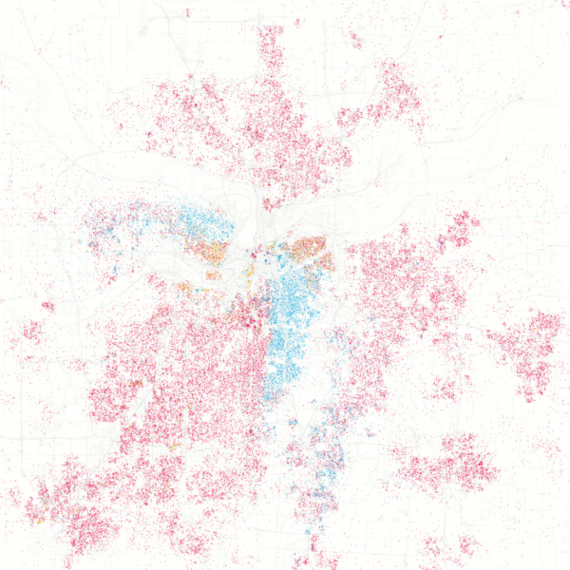Ferguson...Baltimore...Charleston...these are places that will be forever cemented in our minds as victims of community breakdown. But, before you think the same tragedy couldn't happen in your city, think again: the factors at play in those three places are present in every American city.
The good news is we can help stop another Baltimore by crossing the streets that divide us. Every city has a street...I'm sure you thought of yours right away. It's that street that everyone in town knows is the line that divides rich from poor, black from white, and advantaged from disadvantaged. In my hometown of Kansas City, the street is Troost Ave. For decades, it has been known as the street where, once crossed, opportunity becomes a whole lot harder to come by. Let's check out a visual aid on this:
Source: Wikicommons
This is a "map" of Kansas City that was produced by Dustin Cable at U of Virginia. The blue dots represent people of color whereas the red dots represent caucasians. Notice that "line" going right down the middle dividing red from blue? Yup, you guessed it: Troost. I can also promise you that if I overlaid this map with dots tracking poverty and educational outcomes, you'd see that Troost also separates advantaged from disadvantaged.
Let's check another map:
Any guesses? That's Baltimore. Remember, blue dots = people of color, and red = caucasians. Community division anyone?
So, what's my point? The point is we often get so focused on higher level issues of social change that we fail to discuss the change that everyday residents can create simply by crossing the streets that divide us. We millennials especially will travel the world in search of social problems to solve, all the while neglecting the deep divisions within our own urban habitats.
Know this: You serve the best where your roots are deepest. You don't need to galavant around the world to find social problems -- the ones you're best equipped to solve are right across your streets.
How to? There are lots of ways to cross streets. For example, mentorship programs such as Big Brothers/Big Sisters are shown to be highly effective. Community gardens are springing up in the urban core all over the U.S., offering great opportunities for communities to break through dividing lines. There are also a number of stellar organizations in our urban core focused on serving the elderly, which can be a great way to cross the street.
Bottom line is this: next time you think your city could be the next Baltimore (and it can), why not cross a street and get about the business of changing that?

